The History Of Pontiac Firebird

The Pontiac Firebird was built by the Pontiac division of General Motors between 1967 and 2002. The Firebird was introduced the same year as its platform-sharing cousin, the Chevrolet Camaro. This coincided with the release of the 1967 Mercury Cougar, which shared its platform with another pony car, the Ford Mustang.
The vehicles were, for the most part, powered by various V8 engines of different GM divisions. While primarily Pontiac-powered until 1977, Firebirds were built with several different engines from nearly every GM division until 1982 when all Pontiac engines were dropped in favor of corporate units.
The first generation Firebirds had a characteristic "coke-bottle" styling. Unlike its cousin, the Chevrolet Camaro, its bumpers were integrated into the design of the front end and its rear "slit" taillights were inspired by the Pontiac GTO. Both a two-door hardtop coupe and a convertible were offered through the 1970 model year (the next generation, minus the convertible, being announced as 1970½ models). Originally the car was a "consolation prize" for Pontiac, who had initially wished to produce a two-seat sports car of its own design, based on the original Banshee concept car. However, GM feared such a vehicle would directly compete with Chevrolet's Corvette, and the decision was made to give Pontiac a piece of the pony car market by having them share the F-body platform with Chevrolet. Somewhat disappointed at management's decision, Pontiac went about re-making the F-body in their own image with both styling and engineering changes.
The base model Firebird came equipped with the OHC inline-6 and a single-barrel carburetor. The next model, the Sprint, had a four-barrel carburetor, developing 215hp (160kW). But most buyers opted for one of the V8 engines: the 326CID (5.3L) with a two-barrel carburetor producing 250hp (186kW); the "H.O." (High Output) engine of the same displacement, but with a four-barrel carburetor and producing 285hp (213kW); or the 400CID (6.6L) from the GTO with 325hp (242kW). A "Ram Air" option was also available in 1968, providing functional hood scoops, higher flow heads with stronger valve springs, and a different camshaft. Power for the Ram Air package was the same as the conventional 400H.O., but the engine peaked at a higher RPM. The 230CID (3.8L) engines were subsequently replaced by 250CID (4.1L) ones, the first developing 175hp (130kW) using a single barrel carburetor, and the other a 215hp (160kW) engine with a four-barrel carburetor. Also for the 1968 model, the 326CID (5.3L) engine was replaced by one with a displacement of 350CID (5.7L). An "H.O." version of the 350CID with a revised cam was also offered starting in that year, developed 320hp. Power output of the other engines was increased marginally. In 1969, a $725 optional handling package called the "Trans Am Performance and Appearance Package,", named after the Trans Am Series, which included a rear spoiler, was introduced. Of these first "Trans Ams," only 689 hardtops and eight convertibles were made. There was an additional Ram Air IV option for the 400CID engine during that year, complementing the Ram Air III; these generated 345 and 335hp respectively. The 350 "H.O." engine was revised again with a different cam and cylinder heads resulting in 330hp. During 1969 a special 303cuin (5L) engine was designed for SCCA road racing applications that was not available in production cars.
Bodywise, the styling difference from the 1967 to the 1968 model was the addition of Federally-mandated side marker lights: for the front of the car, the blinkers were made larger and extended to wrap around the front edges of the car, and on the rear, the Pontiac (V-shaped) Arrowhead logo was added to each side. Also, Pontiac stopped using wing-windows and started using single panes on the doors. The 1969 model received a major facelift with a new front end design made of an Endura bumper housing the headlights and grilles. Inside, there was a revised instrument panel and steering wheel. Also, the ignition switch was moved from the dashboard to the steering column with the introduction of GM's new locking ignition switch/ steering wheel.
Due to engineering problems that would ultimately delay introduction of the all-new 1970 Firebird beyond the usual fall debut, Pontiac continued production of 1969-model Firebirds into the early months of the 1970 model year — until the end of calendar year 1969 (the other 1970 Pontiac models had been introduced on September 18, 1969). In fact, by late spring of 1969, Pontiac had deleted all model-year references on Firebird literature and promotional materials, anticipating the extended production run of the then-current 1969 models.
The first generation Firebird could be easily distinguished from the Camaro with its four round headlamps, whereas the Camaro only had two.
The second generation debut for the 1970 model year was delayed until February 26, 1970, because of tooling and engineering problems; thus, its popular designation as a 1970 1/ 2 model, while leftover 1969s were listed in early Pontiac literature without a model-year identification. Replacing the "Coke bottle" styling was a more "swoopy" body style, with the top of the rear window line going almost straight down to the lip of the trunk lid — a look that was to epitomize F-body styling for the longest period during the Firebird's lifetime. The new design was initially characterized with a large C-pillar, until 1975 when the rear window was enlarged. There were two Ram Air 400 engines for 1970: the Ram Air III (335hp, 366hp in GTO) and the Ram Air IV (345hp, 370hp in GTO) which were carried over from 1969. The difference between the GTO and Firebird engines was the secondary carburetor linkage which prevented the rear barrels from opening. Bending the linkage to allow full carburator operation resulted in identical engines. A distinctive, slant-nose facelift occurred in 1977, redone somewhat in 1979. From 1977 to 1981, the Firebird used four square headlamps, while the Camaro continued to retain the two round headlights that had previously been shared by both Second Generation designs. Curb weights rose dramatically in the 1973 model year due to the implementation of 5 MPH telescoping bumpers and various other crash and safety related structural enhancements; SD455 Trans Ams tipped the scale at a whopping 3,850 pounds curb.
The 455 engine available in the second generation Firebird Trans Am was arguably the last high-performance engine of the original muscle car generation. The 455 engine first made its appearance in 1971 as the 455-HO. In 1973 and 1974, a special version of the 455, called the SD-455, was offered. The SD-455 consisted of a strengthened cylinder block that included 4 bolt main bearings and added material in various locations for improved strength. Original plans called for a forged crankshaft, although actual production SD455s received modular iron crankshafts with minor enhancements. Forged rods and forged aluminum pistons were specified, as were unique high flow cylinder heads. A 1967 GTO Ram Air camshaft with 301/ 313 degrees of advertised duration, 0.407 inch net valve lift, and 76 degrees of valve overlap was specified for actual production engines in lieu of the significantly more aggressive Ram Air IV style cam that had originally been planned for the engine (initially rated at 310 HP with that cam), but proved incapable of meeting the tightening emissions standards of the era. This cam, combined with a low compression ratio of 8.4 (advertised) and 7.9:1 actual resulted in 290 SAE NET HP. The initial press cars that were given to the various enthusiast magazines (e.g., Hot Rod and Car and Driver) were fitted with the Ram Air IV style cam and functional hoodscoops - a fact that has been confirmed by several Pontiac sources although none of those sources are listed here.[citation needed] There is still some controversy about what cam was used in the early press cars due to an article written by Jerry Heasley for Musclecars magazine titled "Mexican Shooutout." Mr Heasley did not start out with the intention of addressing that question, but in an odd turn of events, he did just that. It all started with a "shootout" between a 1973 SD455 Trans Am and a 1967 440 Dodge Coronet R/ T set to take place at the Houston International Raceway in Texas. The R/ T backed out at the last minute so Heasley decided to run Mike's 81K mile stock Trans Am for comparison against the times that had been published by Car and Driver magazine back in 1973. Out of three runs, Mike bettered the times published by Car and Driver twice, with a best run of 13.75 seconds. While some actual production test cars ran considerably slower and yielded 1/ 4 miles times in the 14.5 second/ 98 MPH range in showroom tune - results that are quite consistent for a car with a curb weight of 3,850 pounds and the rated 290 SAE NET HP figure that some sources suggest was "under-rated," High Performance Pontiac magazine dyno-tested an SD and gave it an honest 371 SAE Net rating. Pontiac offered the 455 for a few more years, but tightening restrictions on vehicle emissions guaranteed its demise. Thus, the 1976 Trans Am was the last of the "Big Cube Birds," with only 7,100 units produced with the 455 engine.
In 1974, Pontiac offered an inline-6, a 185hp 350CID V8, and 175 to 225hp 400CID V8 engines. The 455 produced 215 and 250hp while the SD-455 produced 290hp. The 400, 455, and SD-455 engines were offered in the Trans Am and Formula models during 1974, but the 400 and 455 engines were the only other options in the 1975 and 1976 models. In 1976, Pontiac celebrated their 50th Anniversary, and a special edition of the Trans Am was released. Painted in black with gold accents, this was the first anniversary Trans Am package and the first production Black and Gold special edition. In 1977, Pontiac offered the T/ A 6.6Litre 400 (RPO W72) rated at 200hp, as opposed to the regular 6.6Litre 400 (RPO L78) rated at 180hp. In addition, California and high altitude cars received the Olds 403 engine, which offered a slightly higher compression ratio and a more usable torque band than the Pontiac engines of 1977.
Beginning in 1978, Pontiac engineers reversed years of declining power by raising the compression ratio in the Pontiac 400 through the installation of different cylinder heads with smaller combustion chambers (1977 pontiac 400 engines also had the 350 heads bolted to the 400 blocks, these heads were known as the 6x-4 heads)(taken from the Pontiac 350). This increased power by 10% for a total of 220 during the 1978-79 model years. The 400/ 403 options remained available until 1979, when the 400CID engines were only available in the 4-speed transmission Trans Ams and Formulas (the engines had actually been stockpiled from 1978, when PMD had cut production of the engine). 1979 marked the 10th Anniversary of the Trans Am, and a special anniversary package was made available: silver paint with a silver leather interior. The 10th Anniversary cars also featured a special Firebird hood decal, which extended off of the hood and onto the front fenders. In 1979 Pontiac sold 116,535 Trans Ams which still holds the record to this day. In 1980, due to ever-increasing emissions restrictions, Pontiac dropped all of its large displacement engines.
1980 therefore saw the biggest engine changes for the Trans Am. The 301, offered in 1979 as a credit option, was now the standard engine. Options included a turbocharged 301 or the Chevrolet 305 small block.
In the final year of the Second Generation Firebirds (1981), Trans Am still used the same engines as it had in the previous model year, with the only change being the addition of a new electronic carburation system.
Main article: Third-generation Pontiac FirebirdAs federal mandates had shut down the muscle car era, GM decided the New F-body was to be concerned with handling over horse power. The third generation Firebirds was released with three models: Firebird, Firebird S/ E, and Firebird Trans Am and the cars had more in common with the Camaro than ever, sharing over 60% of parts with each other. The Firebird was the base model, equivalent to the Camaro Sport Coupe; the Firebird S/ E was the mid-trim-level version, which could actually be loaded with as many options as the Trans Am; and the Trans Am, of course, was the performance-level Firebird. The Firebird and Camaro had been completely restyled, with the windshield slope set at 60 degrees (about 3 degrees steeper than anything GM had ever tried before) and for the first time, a large, glass-dominated rear hatchback. Two pop-up headlights, a first on the F-Body cars, were the primary characteristic that distinguished the Firebird from its Camaro cousin; the Firebird would retain this styling characteristic until the end of production in 2002. In addition to being 500 lb (227 kg) lighter, the Third Generation Firebird was the most aerodynamic production Firebird to date. Wind tunnels were used to form the body shape, and the aerodynamic developments extended to the finned aluminum wheels with smooth caps and a functional spoiler. The Trans Am received a "Turbo Bulge" hood, styled loosely after the earlier Turbo Trans Am. In fact, plans had originally been made to use the Pontiac 4.9 Turbo, but they were scrapped at the last minute. However, the hood bulge remained and was made functional for the Crossfire-injected 305. While the S/ E could be had with every option the Trans Am could, it didn't use the bulged hood. Leather seating was also available on all models. Firebirds were available with several engines: the standard fuel-injected 90 hp 2.5L 4 cylinder Pontiac "Iron Duke" (this marked the first time a 4-cylinder engine was offered in the Firebird); a 102 hp 2.8L V6; and two 5.0L V8's. The first and most common was the LG4, a basic carburetor-equipped 305 producing 145 hp. The other was a new fuel-injected 305, which employed a fuel injection system similar to that used in the 1982 Corvette's 5.7L, and produced 165 hp. The base Firebird came standard with 14-inch steel wheels; 14-inch aluminum and 15-inch aluminum wheels were available on the S/ E and Trans Am models. Pontiac had also hoped to drop all the "Trans Am" badges from the new cars to save royalties paid to the SCCA for use of the name. Early promotional cars were marked "T/ A" as an alternative, however the production cars came marked as "Trans Am" regardless. The WS6 option, available on the S/ E's and Trans Ams, included 4-wheel disc brakes, P215/ 65R15 Goodyear Eagle GT radials with 15-inch cast aluminum wheels, stiffer springs, thicker front and rear sway bars, a high ratio 12.7:1 steering box, and limited slip rear differential. There was also the WS7 option, which was the same as the WS6, except for the lack of the 4-wheel disc brakes. In 1983, the Third Generation Trans Am was selected as the Daytona 500 Pace Car, and Pontiac offered a total of 500 Daytona Pace Car replicas through their dealerships. The limited-edition cars featured full body ground effect skirts that extended around the entire car. In 1984, the Trans Am became available with the same ground effects package used on the 1983 Daytona Pace Car replica; the grill inserts in the front fascia were replaced with solid pieces, and new 20-slot, 15-inch aluminum wheels were also available. For the fifteenth anniversary of the Trans Am, Pontiac released another special, limited-edition Trans Am.
For 1985 Firebird models underwent significant redevelopment to boost sales as a number of power train improvements were introduced. The LB9 Tuned Port Injection (TPI) 305 was released, producing 210 hp, which brought it suitable attention from buyers despite being unavailable with a manual transmission. The carbureted V6 was replaced with a new, multi-port fuel-injected 2.8L V6 making 135 hp. The standard Firebird received a restyled nose with wrap-around inserts known as "bumperettes" to replace the old grille/ solid inserts; wrap-around bumperettes were also added to the rear bumper. The Trans Am "Turbo Bulge" hood was discontinued in favor of a new flat hood with twin louvered "nostrils" that were non-functional. Trans Am also received a restyled nose with integral fog lights and newly redesigned ground effects. Also, the full "hood bird" was made available for the first time on this generation of the car as well. In 1986, Firebirds received a center, high-mounted stop lamp (CHMSL) to comply with Federal legislation; these were placed on top of the back hatch window. In 1987 the CHMSL was moved down to the spoiler. The 2.5L 4-cylinder engine was dropped, replaced by the multi-port fuel-injected 2.8L V6 as the standard engine. The Firebird S/ E model was discontinued at the end of the year. The rubber/ vinyl wrap-around rear wing introduced in '85 became standard on Trans Am. In 1987, Firebird Formula was re-introduced replacing the SE, available with a choice of V8's (LG4, LB9 305 TPI, or L98 350 TPI), 16-inch convex wheels, and the earlier Trans Am "Turbo Bulge" hood. The wrap-around wing was updated and now standard on Trans Am and Formula; the regular, flat-surfaced spoiler from earlier Trans Am models was now made standard on Firebird. Trans Am and Formula were also offered with an optional 140 mph speedometer. WS6 was standard equipment on the Formula and GTA. "87 also saw Pontiac's top of the line Trans Am: the GTA, which featured adjustable lumbar supports, digital dash, monochromatic paint, and special badges among other top of the line options. 1988 saw a new option, the notchback, in place of the giant greenhouse hatch window. The fit, however, was poor and few were produced.
The Trans Am was selected to pace the 1989 Indianapolis 500, and Pontiac marketed another pace car replica. This special, 20th Anniversary Turbo Trans Am (TTA), based on the GTA and came equipped with the turbocharged Buick 3.8L V6, originally developed for the Buick Regal Grand National. At the time, these replicas were as close to the actual pace car as any replica previously offered; the only differences between the replica cars and those that actually were on the track during the race were the additions of strobe lights and safety equipment. 1,555 were produced. The TTA was the quickest Trans Am to date. Minor changes were made in 1990 Firebirds as they only received a half-year production run, as Pontiac labored to release the re-styled 1991 model.
All Firebirds received re-styled noses loosely fashioned after the "Banshee IV" show car while Pontiac was developing the all-new Fourth Generation platform. The Trans Am's ground effects were re-styled as well, and were made available on the base model Firebird, but NA on the Formula. The Trans Am and Firebird Formula received a new fiberglass-constructed, flat, wrap-around wing, The Trans Am and GTA received updated two-piece tail lights with "PONTIAC" scripted in orange across the panels, and the center, high-mounted stop lamps were moved to inside the top edge of the rear hatch. In 1991 The Formula was the only third Gen F-body to get to T-tops with a 350 Engine starting in MID year 1991. Also, the car was finally available as a convertible again with the conversions done by ASC, whom a few years earlier did the Camaro conversions as well. 1992 marked the final production year for the Third Generation platform, and as release of the Fourth Generation model was imminent, Pontiac made few changes to the Firebird. One improvement was made on all 1992 Third gens was the addition of some extra bonding agents to stiffen up the cars. The extra bonding was an attempt to correct a long time complaint of many owners was the squeeks and rattles the car made, This also allowed GM to experiment on third gens some of the new technologies which were to be implemented on the fourth generation cars which would be introduced for 1993.
The fourth generation F-body continued the aerodynamic formula initiated by the previous generation but it fell victim to declining sales. As before, the Camaro kept the exposed headlights and the Firebird its pop-up units, with some minor changes. The overall styling of the Firebird more strongly reflected the "Banshee IV" concept car than the 1991 "face lift" received by the Third Generation model.
From 1993 until 1995 (1995 non-California cars), Firebirds received a 3.4L V6 with 160hp, or the 5.7L 275hp LT1 V8. The 1993 Firehawk (only available in Formula trim for 1993) received the SLP package with a functional hood scoop and other performance enhancements that increased power to 305 hp. Only 201 were built for 1993, and they routinely out-performed 1993 Corvettes, leading many to believe that the power rating was purposely underrated to allow the Corvette (also rated at 300hp for the 1993 model year) to be the listed "king of power" (and price tag) for that year. In fact, the LT1 in the Formula and Trans Am was very similar to the one in the Corvette C4, except with 2-bolt mains and a more restrictive intake/ exhaust system.
1994 marked the 25th Anniversary of the Trans Am, and another Anniversary Edition was released, painted white with a single blue stripe down the center of the vehicle — clearly reminiscent of the 1970 Trans Am.
1995 models were the same as those of previous years, but traction control (ASR: Acceleration Slip Regulation) was now available. The steering wheel was also changed. It was borrowed from the Grand Prix.A freerer air intake was given, and a higher red line was given able to reach 7000rpm.The computer was revised allowing the engine to produce higher amounts of power and torque.There are 15 cars sold with this package which was a dealer deal.The only way to know which cars were with this packages is at the dyno.It was able to reach 0-60 mph in 4.9 sec in the hands of daily drivers, and 4.5 sec in the hands of professional drivers on cars that had the manual six-speed.
1996 and later models had a 200hp 3.8L V6 as the base engine, and the power rating of the LT1 had been raised to 285, thanks to a new dual catalytic converter exhaust system which was offered in previous years by order only.
The very rare 1997 Firehawk LT4 model, made by SLP Performance Parts and sold through Pontiac dealerships, had 330hp (243 kW) and 340 ft·lbf (459 Nm) of torque.
In 1998, the Firebird received a "face lift" dominated by a new front fascia (now with four pop-up headlights) as well as other modifications, the most significant of which was the introduction of the latest Corvette small block V8 engine, the LS1. Initially, the color "Bright Purple Metallic" had been available, however it was discontinued due to poor sales (not due to production issues with the paint, as rumors have implied). The color was replaced with "Navy Blue Metallic," but not before a total of 12 Trans Am models with the WS6 Ram Air package (10 coupés and 2 convertibles) made it out of the factory dressed in "Bright Purple Metallic." For 1998-2002 Pontiac utilized the same heavy duty brakes, steering ratios, fuel pumps and shocks (non-WS6) on both V6 and V8 models.
1999 marked the 30th Anniversary of the Trans Am since it's release in 1969, and Pontiac commemorated this event by creating another white Anniversary Edition Trans Am. This commemorative package came with twin blue stripes which more closely patterned the original paint scheme of the 1969 Trans Am. Along with the stripes, blue streamline graphics were added on the sides and blue anodized wheels were included with this package.
The final model year of the Firebird, 2002, offered a distinctive "Collector's Edition" Trans Am, painted yellow. Like the Chevrolet Camaro, the Fourth Generation Firebird and Trans Am were built in Sainte-Thérèse, Quebec, and the plant closed down after producing the last F-body cars. This marked the 35th anniversary of the F-Body cars since their initial release.
The LS1 Firebirds, despite their poor sales, were among the fastest ever produced. Outfitted with the all-aluminum 5.7L V8 from the Corvette C5, and producing 305 hp at 5,200 rpm; 335ft·lbf (454N·m) , 454 Nm @ 4,000 rpm (310 after 2000) or 320hp (325 after 2000) in the WS-6 "Ram Air" version, these Fourth Generation Firebirds could out-perform just about any of their predecessors (including the original "muscle car" Firebirds). In 2001 and 2002, models equipped with a V8 received the higher-flow LS6 intake manifold and a higher-performance clutch. Firebird enthusiasts believe these engines were underrated by the factory, and that these cars often produce up to 20 horsepower (30 kW) more than rated, routinely achieving 310 horsepower at the rear wheels. The rare Firehawk model, made by SLP and sold through Pontiac dealerships, had 330hp (335 after 2000, 345 in late 2002 models equipped with the optional Blackwing intake.). Even the last of the V6-equipped Firebirds were rated at an impressive 205hp, which was more than some of the earlier-generation V8's could muster (in fact, the final V6 Firebirds are as quick as almost any V8-equipped Firebird produced before 1985). Average quarter-mile elapsed times for the Fourth Generation Firebirds were reported as 15.2 seconds at 90mph (140km/ h) for V6-equipped vehicles, and 13.2 seconds at 110mph (180km/ h) for those with the V8; in the hands of an experienced driver, the latter cars have even been known to "crack" the 12-second quarter mile mark. Top speeds for both the V6 and V8 versions were generally governed according to their factory tire ratings, which were typically 118mph (190km/ h) for the V6 models. However, with the governor programmed out and applying V8 speed rated tires, V6 Firebirds will reach in excess of 130mph (210km/ h) (4th gear limited) with the Y-87 performance package and a 5-speed transmission, whereas V8 models that had Z-rated tires had a speed limiter set to 167mph (269km/ h).
V6 Firebird
1993-1998 had angular cable driven throttle body units, which later changed in 1999 to a less restrictive drive by wire electronic controlled with 18 reference throttle position points. 1999-2002 also saw the change of mass airflow sensor technology. GM, ridding themselves of the cast rod Mass Airflow Sensor in the Throttle Body, chose the higher flow capacity of the top mount MAF sensor and eliminating the angled induction to a straight forward ram air style intake which removes a large portion of the restriction.
In 2000-2002 Firebird also received an upgraded exhaust manifold from rectangular cast Iron primaries to a round tubular style manifold giving further gains in performance.
First generation
- 1967: OHC 6 & Sprint, 326CID V8, 326CID V8 H.O., 400CID, 400CID Ram Air
- 1968: OHC 6 & Sprint; 350CID; 350 H.O.; 400CID; 400CID H.O.; Ram Air II 400CID (mid-year release; underrated)
- 1969: 350CID; 350.H.O.; 400CID; Ram Air III 400CID; Ram Air IV 400CID (underrated)
Second generation
- 1970: 250CID I6, 350CID V8, 400CID V8, Ram Air III 400CID (Pontiac), Ram Air IV 400CID (Pontiac), Late Release 455 H.O. Pontiac (High Compression)
- 1971: 250CID six-cylinder, 350CID V8, 400CID V8, Base 455CID, 455CID H.O.(Low Compression)
- 1972: 250CID six-cylinder, 350CID V8, 400CID V8, Base 455CID, 455CID H.O.(Low Compression)
- 1973: 250CID six-cylinder, 350CID V8, Base 455CID, 455CID H.O., 455CID S.D.
- 1974: 250CID six-cylinder, 350CID V8, 400CID V8, Base 455CID, 455CID H.O., 455CID S.D.
- 1975: 250CID I6, 350CID V8, 400CID V8, 455CID V8
- 1976: 250CID I6, 350CID V8, 400CID V8, 455CID V8
- 1977: 231CID V6, 301CID V8, 302CID V8, 350CID V8, 400CID V8 (Pontiac), 403CID V8 (Oldsmobile)
- 1978: 231CID V6, 301CID V8, 302CID V8, 350CID V8, 400CID V8 (Pontiac), 403CID V8 (Oldsmobile) Also Available was a 350 chevrolet engine as well
- 1979: 231CID V6, 301CID V8, 305CID V8, 350CID V8, 400CID V8 (Pontiac), 403CID V8 (Oldsmobile)
- 1980: 301CID (Pontiac), 305CID (4-speed only) (Chevrolet), 301CID Turbo (Pontiac)
- 1981: 301CID (Pontiac), 305CID (4-speed only) (Chevrolet), 301CID Turbo (Pontiac)
Third generation
Main article: Third-generation Pontiac Firebird#Third-generation enginesFourth generation
- 1993: L32 3.4L, LT1 5.7L (350CID iron block, aluminum heads)
- 1994: L32 3.4L, LT1 5.7L (350CID iron block, aluminum heads)
- 1995: L32 3.4L, L36 3.8L, LT1 5.7L (350CID iron block, aluminum heads)
- 1996: L36 3.8L, LT1 5.7L (350CID iron block, aluminum heads)
- 1997: L36 3.8L, LT1 5.7L (350CID iron block, aluminum heads) / LT4 5.7L (350CID iron block, aluminum heads) in Firehawk by SLP
- 1998: L36 3.8L, LS1 5.7L (346CID aluminum block and heads)
- 1999: L36 3.8L, LS1 5.7L (346CID aluminum block and heads)
- 2000: L36 3.8L, LS1 5.7L (346CID aluminum block and heads)
- 2001: L36 3.8L, LS1 5.7L (346CID aluminum block and heads)
- 2002: L36 3.8L, LS1 5.7L (346CID aluminum block and heads)
Performance
The Trans Am was a specialty package for the Firebird, typically upgrading handling, suspension, and horsepower, as well as minor appearance modifications such as exclusive hoods, spoilers, fog lights and wheels. In using the name Trans Am, a registered trademark, GM agreed to pay $5 per car sold to the SCCA. Four distinct generations were produced between 1969 and 2002. These cars were built on the F-body platform, which was also shared by the Chevrolet Camaro.
The second generation was available from 1970 to 1981 and was featured in the 1977 movie Smokey and the Bandit, the 1978 movie Hooper and the 1981 movie Smokey and the Bandit II. The third generation, available from 1982 to 1992, was featured in the 1983 movie Smokey and the Bandit Part 3 and the 1984 movie Alphabet City. KITT and KARR, the automotive stars of the popular 1980s TV series Knight Rider, were modified third generation Trans Am. The fourth generation Trans Am, available from model years 1993 to 2002, offered between 275 and 325 horsepower.
Although the Trans Am nameplate was discontinued along with the Firebird in 2002, the body was used in the IROC Racing Series until the series' closing in 2006.
Trans Am engines
First generation
1969: Ram Air III 400 (Pontiac), Ram Air IV 400 (Pontiac) 345 hp, Ram Air V 400 (Pontiac) 500 hp
Second generation
- 1970: Ram Air III 400 (Pontiac), Ram Air IV 400 (Pontiac), Ram Air V 400 (Pontiac, rare dealer-installed option)
- 1972: Base 455 (Pontiac), 455 H.O. (Pontiac)
- 1973: Base 455 (Pontiac), Super Duty 455 (Pontiac)
- 1974: 400 (Pontiac), Base 455 (Pontiac), Super Duty 455 (Pontiac)
- 1975: 400 (Pontiac), 455 (Pontiac)
- 1976: 400 (Pontiac), 455 (Pontiac)
- 1977: 403 (Oldsmobile), 455 (Pontiac), W72 400 (Pontiac)
- 1978: 403 (Oldsmobile), 455 (Pontiac), W72 400 (Pontiac)
- 1979: 301 (Pontiac), 403 Oldsmobile, W72 400 (Pontiac)
- 1980: 301 (Pontiac), 305 (4 speed only) (Chevrolet), 301 Turbo (Pontiac)
- 1981: 301 (Pontiac), 305 (4 speed only) (Chevrolet), 301 Turbo (Pontiac)
Third generation
From 1982 on all engines are Chevrolets unless stated otherwise.
- 1982: 305 4 barrel, 305 Cross-Fire Injection (First year for fuel injection in Trans Am)
- 1983: 305 4 barrel, 305 Cross-Fire Injection, 305 4 barrel H.O. (Only 662 were made; all 5-speeds)
- 1984: 305 4 barrel, 305 4 barrel H.O.(1500 anniversary editions, 500 of them 5 speed)
- 1985: 305 4 barrel, 305 Tuned Port Injection, 305 4 barrel H.O. (5 speed only)
- 1986: 305 4 barrel, 305 Tuned Port Injection, 305 4 barrel H.O. (5 speed only)
- 1987: 305 4 barrel, 305 Tuned Port Injection, 350 Tuned Port Injection
- 1988: 305 Throttle Body Injection, 305 Tuned Port Injection, 350 Tuned Port Injection
- 1989: 305 Throttle Body Injection, 305 Tuned Port Injection, 350 Tuned Port Injection, 231 Turbo (Buick)
- 1990: 305 Tuned Port Injection, 350 Tuned Port Injection
- 1991: 305 Tuned Port Injection, 350 Tuned Port Injection 305 tbi
- 1992: 305 Tuned Port Injection, 350 Tuned Port Injection
Fourth generation
- 1993: LT1 350
- 1994: LT1 350
- 1995: LT1 350
- 1996: LT1 350
- 1997: LT1 350
- 1998: LS1 346
- 1999: LS1 346
- 2000: LS1 346
- 2001: LS1 346
- 2002: LS1 346
For the thirtieth anniversary of the hit movie Smokey and the Bandit, Year One Muscle Cars and Burt Reynolds (the movie's star) reinvented the 2nd Generation Trans Am. The revitalized classic is offered in three options: "Ban One", "Ban Two", and "Ban Three". They are restored 1977 and 1978 Trans Ams but with a twist. This new Trans Am has many new options.
The Ban One has a 462 cubic inch traditional Pontiac V8 with aluminum heads, 9.5:1 compression and a hydraulic roller camshaft. The engine made 496 horsepower on the dyno. The transmission is a five-speed manual, and the suspension system features upper and lower tubular control arms with coil springs up front, and performance leaf springs in the rear, with sub frame connectors keeping everything properly located. Wheels are 18” x 9” billet aluminum snowflakes all the way around. It, along with all other models, come with a CB Radio.
The Ban Two has a 461 cubic inch, 430 horsepower traditional Pontiac V8, while optional powerplants include a 500-horsepower LS2 based fuel-injected engine, a 550-horsepower Pontiac V8 or a 600-horsepower supercharged LS2. A five-speed manual overdrive with short throw shifter is the standard transmission, and a four-speed automatic overdrive is optional. The suspension system is completely redesigned on Ban II-level cars, and features a tubular front subframe, rack-and-pinion steering, four-link rear suspension, with adjustable coil-over shocks all the way around. The chassis is reinforced with integrated subframe connectors and is mini-tubbed in the rear for additional wheel and tire clearance. Wheels are 18” x 10” billet aluminum snowflakes on all four corners, with 285-35-18 BFG tires. Brakes are from Baer Racing, with 13” two-piece front rotors.
The Ban Three has a 515-horsepower dry-sump LS7 7.0 liter engine, and upgrades include a 605-horsepower dry-sump LS7, or a monster 8.8 liter (540 cubic inch) Pontiac V8 making over 650 horsepower. A five-speed manual is the only transmission offered on the Ban III. Suspension consists of the Ban II’s tubular front subframe, rack-and-pinion steering, and four-link rear with adjustable coil-overs on each corner. Chassis reinforcements include integrated subframe connectors and a four-point roll bar with safety harnesses. Brakes are huge Baer Racing six-piston calipers with 14-inch two-piece rotors front and rear. The Ban III offers a level of performance rarely seen in a street-legal vehicle.
Firebirds were used in the Trans-Am series in the 1960s and 1970s. When the Pontiac Trans Am came out, there was controversy over the model's inability to compete in the Trans-Am because the smallest available engine was too large for use in the series at 400 cubic inches (6.6 liters). The name also caused controversy because it was used without permission from the SCCA, who threatened suit. GM settled the dispute by paying US$5 to the SCCA for every car sold. When the Trans-Am was last seen, model year 2002 Firebirds were in use. Firebirds were used in the IROC Series for a number of years.
During the 1996 and 1997 NHRA seasons, 14-time Funny Car champion John Force used a Firebird body to replace the obsolete Oldsmobile Cutlass body he had used since 1986. He used it for two seasons, winning the championship in both years.
From Wikipedia, the free encyclopedia
More About Pontiac Firebird
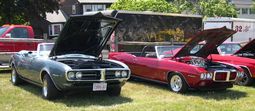
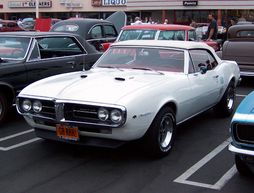
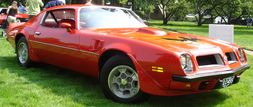
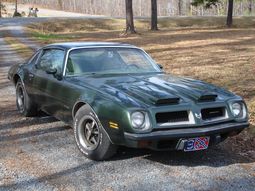
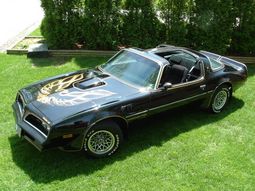
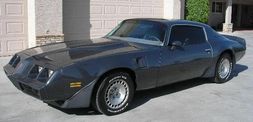
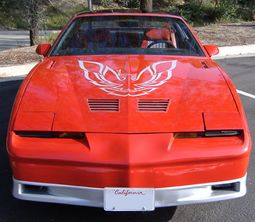
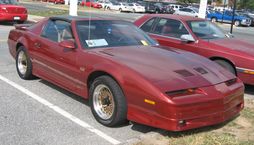
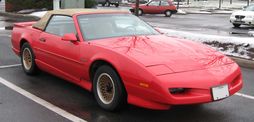
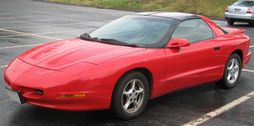
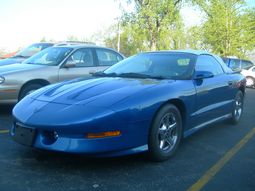
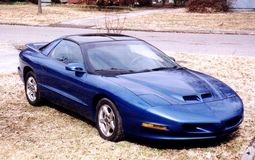
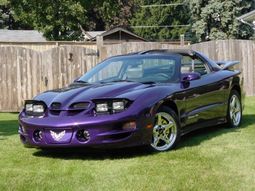
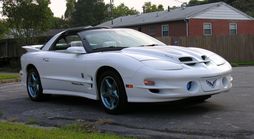
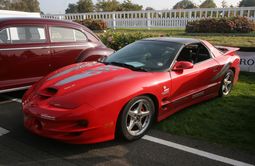
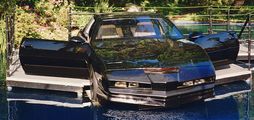
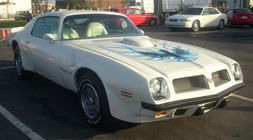
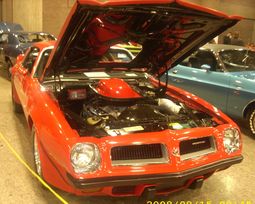
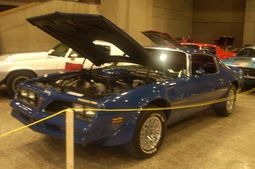
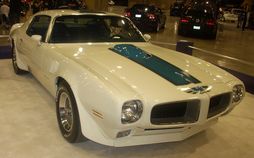
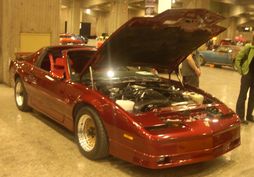
|